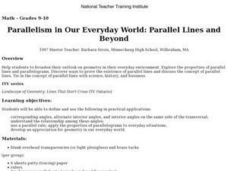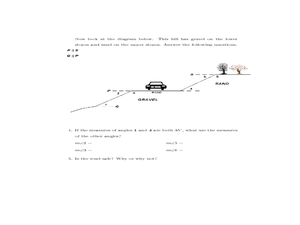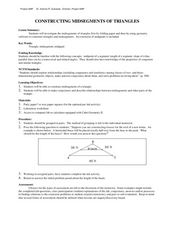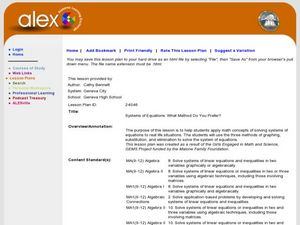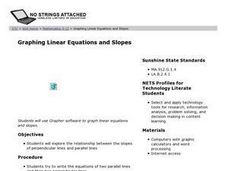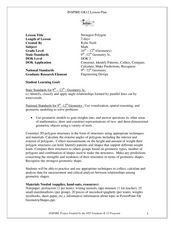Curated OER
Identifying Linear Functions from Graphs
Keep your mathematicians engaged using this group linear functions activity. Each of ten groups receives two graphs with both an image and equation, as well as a "who has" phrase to call out the next graph. Scholars stay on their toes as...
Curated OER
Parallelism in Our Everyday World: Parallel Lines and Beyond
Students broaden their outlook on geometry in their everyday environment. They explore the properties of parallel lines and parallelograms and discover ways to prove the existence of parallel lines and discuss the concept of parallel lines.
Curated OER
Making Parallel Lines
Students differentiate between parallel and perpendicular lines. In this geometry lesson, students make conjectures and apply it to solve real life situations. They collect data and make predictions based on the data.
Curated OER
Parallel-o-Home
Learners investigate the usage of parallel and perpendicular shapes in the real world. For this geometry lesson, students investigate shapes for properties that are related to the real world. They relate all the properties of shape tot...
Mathematics Assessment Project
Identifying Similar Triangles
Math whizzes work with angle sums and exterior angles to figure out the measure of other angles. This particular publication provides comprehensive support in the form of an anticipatory activity, questions designed to prompt discussion,...
Curated OER
Exploring the Slopes of Parallel and Perpendicular Lines
Students calculate the slope of parallel and perpendicular lines.In this algebra instructional activity, students differentiate between parallel and perpendicular lines. They graph their lines using the slope of the equation.
Curated OER
Exploring the Slopes of Parallel and Perpendicular Lines.
Students find the slopes for perpendicular and parallel lines. In this geometry lesson, students differentiate between parallel and perpendicular lines. They use Cabri software to create lines to compare.
Curated OER
The Tipping Point
Students rewrite word problems and solve using math. In this word problem lesson, students gather data and observe the data. They relate this process to the scientific method and math. They review their data to be able to answer...
Curated OER
Side Splitter Triangles
Students investigate the side splitter theorem. In this geometry instructional activity, students estimate and solve problems dealing with ratios and proportions. They identify angles created by lines that are parallel.
Curated OER
Constructing Midsegments of Triangles
Students construct midsegments. In this geometry lesson, students make conjectures and apply properties of triangles to solve problems. They complete an activity on the computer.
Curated OER
Systems of Equations: What Method Do You Prefer?
Students explore the concept of solving systems of equations. In this solving systems of equations lesson, students watch YouTube videos about how to solve systems by graphing and by elimination. Students use an interactive website to...
Curated OER
Graphing Linear Equations and Slopes
Pupils explore linear equations, parallel lines, perpendicular lines and slopes. Using computers with graphic calculators and word processing, students examine the relationship between the slopes of perpendicular lines and parallel...
Curated OER
Reflections over Two Lines & Dilations
Students create reflections over two lines. In this reflections worksheet, students compare and contrast reflections over parallel and intersecting lines. They dilate figures and investigate the effect of the dilation using measurement...
Curated OER
Light Bounce
Students solve problems involving triangles. In this geometry lesson plan, students apply properties of triangles to find the missing angles and sides. They identify angles of parallel lines cut by a transversal.
Curated OER
How Far Am I Traveling
Students solve for missing sides using the Pythagorean theorem. In this algebra lesson, students derive the six trigonometric values using the right triangle. They relate the Pythagorean theorem to the distance formula.
Curated OER
Applications of Properties of Quadrilaterals in the Coordinate Plane
Learners explore the concept of quadrilaterals. In this quadrilaterals lesson plan, students use the slope formula, midpoint formula, and distance formula to justify that a given quadrilateral is a parallelogram.
Curated OER
Incredible Edible Bridges
Students create a bridge using engineering and geometric concepts. In this geometry lesson plan, students identify the missing measures of polygons sides and angles. They work together to solve real life situation using problem solving...
Curated OER
Race The Rapper: Slopes
Young scholars calculate the slope of the equation In this algebra lesson, students graph coordinate pairs of linear equations and identify the relationship between x and y values and slope. They differentiate between functions and...
Curated OER
Introduction to Locus
Students define the five rules of loci. In this geometry lesson, students identify the locus of points that creates a circle. They calculate the distance from a fixed line and point.
Curated OER
Strongest Polygon
Pupils define and identify shapes by name. In this geometry lesson, students construct, identify and compare polygons based on the number of sides. They classify each shape based on their angle sum theorem.



